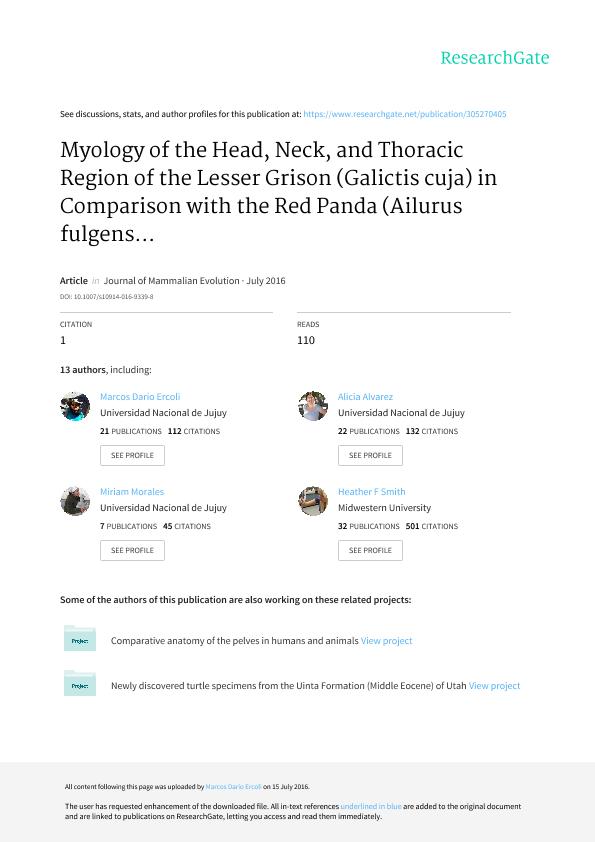Artículo
Myology of the Head, Neck, and Thoracic Region of the Lesser Grison (Galictis cuja) in Comparison with the Red Panda (Ailurus fulgens) and Other Carnivorans: Phylogenetic and Functional Implications
Ercoli, Marcos Darío ; Alvarez, Alicia
; Alvarez, Alicia ; Busker, Felipe
; Busker, Felipe ; Morales, Miriam Mariana
; Morales, Miriam Mariana ; Julik, Emily; Smith, Heather F.; Adrian, Brent; Barton, Mike; Bhagavatula, Keerthi; Poole, Meifawn; Shahsavan, Matt; Wechsler, Rachel; Fisher, Rebecca E.
; Julik, Emily; Smith, Heather F.; Adrian, Brent; Barton, Mike; Bhagavatula, Keerthi; Poole, Meifawn; Shahsavan, Matt; Wechsler, Rachel; Fisher, Rebecca E.
 ; Alvarez, Alicia
; Alvarez, Alicia ; Busker, Felipe
; Busker, Felipe ; Morales, Miriam Mariana
; Morales, Miriam Mariana ; Julik, Emily; Smith, Heather F.; Adrian, Brent; Barton, Mike; Bhagavatula, Keerthi; Poole, Meifawn; Shahsavan, Matt; Wechsler, Rachel; Fisher, Rebecca E.
; Julik, Emily; Smith, Heather F.; Adrian, Brent; Barton, Mike; Bhagavatula, Keerthi; Poole, Meifawn; Shahsavan, Matt; Wechsler, Rachel; Fisher, Rebecca E.
Fecha de publicación:
09/2017
Editorial:
Springer
Revista:
Journal of Mammalian Evolution
ISSN:
1064-7554
e-ISSN:
1573-7055
Idioma:
Inglés
Tipo de recurso:
Artículo publicado
Clasificación temática:
Resumen
The lesser grison (Galictis cuja) and the red panda (Ailurus fulgens) represent two opposed morpho-functional musteloid extremes. The mid-sized lesser grison is primarily terrestrial, a frequent burrow-dweller, and carnivorous, while the larger, scansorial red panda eats bamboo. This study documents the axial myology of these species, including muscle descriptions, weights, and optimizations. Muscle maps are also provided for the lesser grison, representing the first axial maps for a wild-caught carnivoran. The functional analyses revealed that G. cuja, contrary to A. fulgens, possesses longer, stronger, and subdivided neck muscles. It also possesses a thoraco-lumbar iliocostalis system that is more developed than the longissimus complex, and numerous, robust, and laterally inserted deep bellies of the cervical and thoracic transversospinalis systems. These specializations allow powerful neck movement during hunting and transport of heavy prey as well as axial flexibility, facilitating bounding gaits and lateral movements while navigating subterranean galleries. Some myological traits of the red panda differ from those expected in a highly herbivorous taxon (e.g., m. sternocephalicus, m. masseter), and may reflect its depredatory ancestry. The optimization analysis revealed phylogenetically informative traits across Carnivora, including the absence of m. longissimus capitis in Mephitidae, the absence of spinous thoracic origins for m. biventer cervicis in Musteloidea, and the presence of a relatively lateral insertion of m. rectus dorsalis capitis intermedius in the clade Ictonychinae+Lutrinae+Mustelinae. This study reveals key associations between axial myological and osteological features that will prove useful for future studies of carnivorans.
Palabras clave:
AILURUS
,
AXIAL MYOLOGY
,
CARNIVORA
,
FUNCTIONAL MORPHOLOGY
,
GALICTIS
,
PHYLOGENY
Archivos asociados
Licencia
Identificadores
Colecciones
Articulos(CCT-CENPAT)
Articulos de CTRO.CIENTIFICO TECNOL.CONICET - CENPAT
Articulos de CTRO.CIENTIFICO TECNOL.CONICET - CENPAT
Articulos(INECOA)
Articulos de INSTITUTO DE ECORREGIONES ANDINAS
Articulos de INSTITUTO DE ECORREGIONES ANDINAS
Articulos(MACNBR)
Articulos de MUSEO ARG.DE CS.NAT "BERNARDINO RIVADAVIA"
Articulos de MUSEO ARG.DE CS.NAT "BERNARDINO RIVADAVIA"
Articulos(SEDE CENTRAL)
Articulos de SEDE CENTRAL
Articulos de SEDE CENTRAL
Citación
Ercoli, Marcos Darío; Alvarez, Alicia; Busker, Felipe; Morales, Miriam Mariana; Julik, Emily; et al.; Myology of the Head, Neck, and Thoracic Region of the Lesser Grison (Galictis cuja) in Comparison with the Red Panda (Ailurus fulgens) and Other Carnivorans: Phylogenetic and Functional Implications; Springer; Journal of Mammalian Evolution; 24; 3; 9-2017; 289-322
Compartir
Altmétricas



